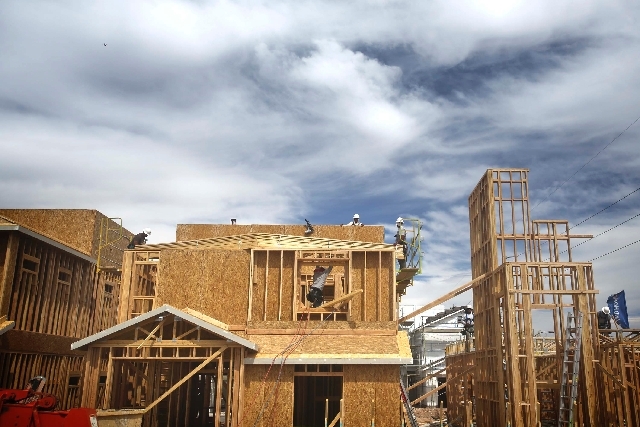Realtors official: Tight inventory, high prices may persist
If you see nothing but doom and gloom in today’s frothy housing market, some industry experts have a message for you: Buck up.
Sure, housing prices have spiked as investors snap up short supplies. And yes, real estate faces headwinds such as rising interest rates, lack of supply and possible changes in federal policies, such as mortgage-interest tax deductions.
But this isn’t 2006 — not even close, said Lawrence Yun, chief economist and senior vice president of the National Association of Realtors. Yun was in town Friday to speak to a group of 400 local sales agents at the Greater Las Vegas Association of Realtors’ membership luncheon inside the Gold Coast.
For starters, Yun said, building activity is way down. New-home closings nationwide are just 28 percent of what they were at the peak, and new-home inventory is at a 50-year low. Likewise, numbers from Sales Traq, a local housing analysis firm, showed 764 new-home permits issued in May, down from more than 4,000 a month during the boom.
If those kinds of levels persist, Yun said, the city’s tight inventory will only worsen, and that’ll keep prices up.
“Anytime you have this shortage of inventory, builders should respond, but they’re not responding aggressively.” Yun said. “They’re responding slowly.”
That’s because banks are cautious about construction loans, he said, and unless lending loosens, expect up to two more years of housing shortages.
Yet, there will be more people to buy. The nation has created 2 million net new jobs in the recovery, and that means more demand for homes. Nor should rising interest rates hurt demand, because even at 4.5 percent, borrowing costs are well below historical standards.
That’s if you can get a loan. Unlike during the 2006 bubble, banks are tight with credit. Long gone are the no-documentation loans and the nothing-down, 100 percent loan-to-value mortgages that inflated the market before the recession, though Yun suggested the banks might loosen credit standards a little in coming months and years.
If federal loan guarantors such as Fannie Mae merely dropped their credit-score requirements from today’s 770 to a still-reasonable 720, an additional 15 percent to 20 percent of people could qualify to buy, he said.
So putting it all together, just how much room is there for added price gains? Look at the difference in prices between Phoenix and Las Vegas for a hint, Yun said. Prices in Phoenix run 20 percent higher on average than prices in Las Vegas, so median prices here could go up that much more to catch up with Southern Nevada’s nearest comparable market, he said. What’s more, rising material costs have widened the gap between the cost of a new home and a resale. The median new-home price was $255,565 in May, while the median resale came in at $142,150, according to SalesTraq. So resale values could easily grow a bit more without any fretting over a bubble.
“Today’s price increases are well-justified,” Yun said.
And all that’s before you consider improved economic activity in the local market.
Save traffic through McCarran International Airport and resale closings, every key economic indicator is up, said Jeremy Aguero, a principal with Applied Analysis and SalesTraq.
The state’s gross domestic product grew 3.7 percent in 2011 and 3.2 percent in 2012, after shrinking 6.7 percent in 2009. Population growth is at 1.4 percent, good for third in the West after Texas and Utah, and ahead of Arizona and California. Plus, Las Vegas ranks sixth in the West for job growth .
Rising home prices mean $14.6 billion — or $30,000 per household — in additional local home equity in the last year, Aguero said. Even personal incomes are growing.
“And what are they doing with those incomes? They’re spending,” he said.
That cycle brings with it a surge in local investments, from the $500 million Shops at Summerlin Centre to Genting Group’s planned Resorts World Las Vegas, a Strip project that could cost $2 billion to $7 billion to build, Aguero said. Using conservative estimates, there’s $8 billion in projects under way here, a level inconceivable just two years ago.
“If someone can find me another community at or near our size with $8 billion in investments, I’d love for you to show it to me. I don’t think you can,” Aguero said.
The gain in economic activity leaves room for housing prices to rise. SalesTraq pegs an overall market median of about $150,000, down from $280,000 at the peak, but up from $100,000 at the bottom. Aguero said he thinks economic conditions warrant $180,000.
None of that is to dismiss lingering problems. Construction jobs are still less than half of their number at the peak, and workers in the sector make up half of Nevadans getting unemployment benefits. Nor can the market stabilize when 60 percent of buyers are cash purchasers, mostly investors. A resale inventory of 1.3 months is a fraction of the six months it would be in a balanced market. And artificially suppressed foreclosure volumes caused by — depending on who you ask — state policies or bank manipulation “isn’t a problem we’ve worked through,” Aguero said.
“It’s a problem we’ve shoved under the rug and told to never come back out again.”

RELATED STORY






















